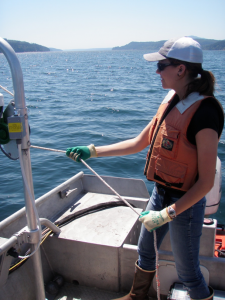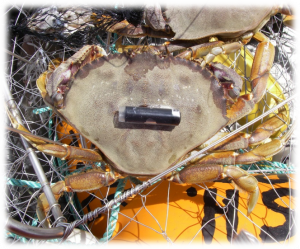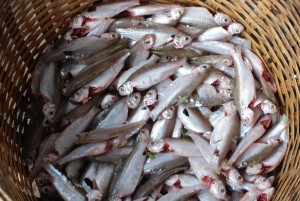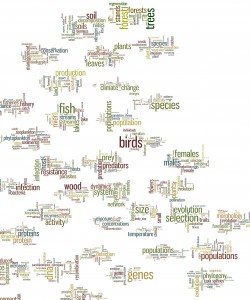Tag Archives: fisheries
When does hypoxia affect management performance of fisheries? A MSE of Dungeness crab fisheries in Hood Canal, WA
Hypoxia [dissolved oxygen (DO) < 2 mg/L] is one of the key threats to some of the most productive regions of the marine environment (e.g., estuaries). Although mortality can occur, mobile organisms have the potential to avoid the most severe low oxygen conditions, but suffer ecologically significant indirect and sublethal impacts as a result. In Washington State, USA, a fjord estuary of the Puget Sound marine ecosystem, known as Hood Canal (110 km), regularly experiences seasonal hypoxia. My dissertation addresses several important gaps in the current knowledge pertaining to the non-lethal biological effects of hypoxia on the mobile benthic and pelagic species of Hood Canal – for the sake of time and your sanity, I’ll be focusing on the benthos. Using acoustic telemetry, I quantified movement patterns and distributional shifts of Dungeness crab (Metacarcinus magister), an abundant and widely distributed species. Although highly mobile, Dungeness crab displayed more localized, rather than large-scale, directional movement relative to hypoxia. More specifically, the tagged crabs showed significant distributional shifts towards shallower waters. As one of the most important fisheries in Puget Sound, I wanted to then investigate the generalized relationship between hypoxia and the Dungeness crab harvest (3-S) management strategy. Inferred by the shoaling behavior from the field, an age-structured population model was constructed to test several hypoxia-scenarios with other stressors, including harvest, illegal crab fishing, and incidental capture mortality. It was found that the 3-S management strategy is most sensitive to the influence of hypoxia when other sources of demographic restrictions are considered, underscoring the uncertainty associated with a data-poor species under multiple anthropogenic and environmental stressors.
Halley E. Froehlich, Ph.D. (Halley is the untagged one on the left)
Postdoctoral Researcher
A spectral framework for forecasting near term inland fisheries in the Mekong River under climate change
John Sabo, a visiting researcher from Arizona State University, will be presenting this week’s roundtable! He will be telling us about his work in the ecologically and economically important Mekong River Basin. We will be continuing the climate change theme from last week’s talk, but moving onto its impacts on fisheries instead. He will also discuss how dams have impacted the river and fisheries.
Abstract: Inland capture fisheries on the Mekong River provide a majority of the animal protein and vitamin A to the diets of over 40M people in the Lower Mekong River Basin. The productivity of this fishery is fueled by the monsoon flood pulse which creates wetlands the size of small US states in Cambodia and Vietnam. The region is experiencing rapid development, including the planning and impending construction of over 20 hydropower facilities, some already built. Climate change will also likely change the intensity and timing of the South Asian Monsoon, with implications for the extent of the ensuing flood pulse and the fishery that depends on it. In this roundtable I will address two topics. First, I present the results from a century scale analysis of change in hydrologic variation and key aspects of the flood pulse on the Mekong River including an assessment of current dams. This analysis is done within a novel spectral framework that allows for identification of baseline stationarity and decomposition of the linear, seasonal and stochastic components of change in daily discharge. Second I link spectral measures of hydrologic variation to catch data from the fishery using a 15-year dataset of the Dai fishery on the Tonle Sap River (Cambodia) and a second time series approach—a multivariate autoregressive state space (MARSS) model. The spectral-MARSS framework is then used to forecast the fishery under near time climate change. Daily discharge variation and key aspects of the flood pulse have been experiencing natural change for over a century. Existing dams have modified discharge in spite of a shifting baseline. Fisheries catch varies with several spectral measures of daily discharge variation. Surprisingly, low flows have equal if not higher positive effect sizes than high flows on catch in this flood pulse system and spectral measures outperform “first moment” measures of flood pulse extent. Moreover, antecedent hydrology—the flood drought sequence from the previous 1-2 years—significantly affects current catch in the fishery. These results suggest that the spectral-MARSS framework may provide a robust tool for forecasting fisheries production in the future.
Do synthesis centers produce novel, potentially transformative research? Research publication diversity as an indicator of novelty and transformative capacity
For this Roundtable, I will present a poster that I presented at the recent AAAS meeting in San Jose. The project is an outgrowth of a working group jointly supported by NCEAS and NESCent and led by Ed Hackett and John Parker. Please read the abstract below for a bit of background, and then come prepared to discuss how you think academic publications (including yours!) produced through synthesis center work might be measurably different from other publications in the field. Then we’ll see if your intuitions are supported by the data we have available. Prepare yourselves to either be really proud of your keen intuitions, or to be surprised by our results!
You can access the poster on figshare using this link: http://dx.doi.org/10.6084/m9.figshare.1314918
Update: To initiate discussion prior to the meeting, I’ve put a question up on Tricider, and I welcome you to use the link below to add your ideas, comment on others’ ideas, and/or vote on the ideas that have been suggested. The question is the following:







